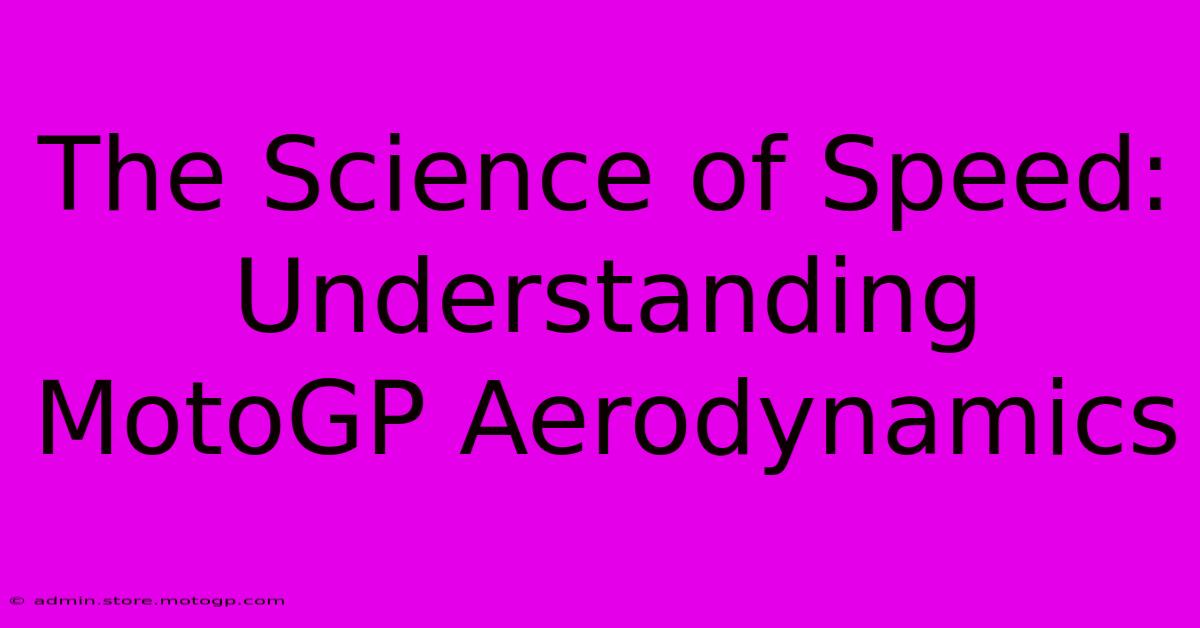The Science Of Speed: Understanding MotoGP Aerodynamics

Table of Contents
The Science of Speed: Understanding MotoGP Aerodynamics
MotoGP. The pinnacle of motorcycle racing. The roar of the engines, the breathtaking speeds, the nail-biting finishes – it's a spectacle fueled by cutting-edge technology. But beyond the horsepower and rider skill lies a crucial element often overlooked: aerodynamics. This article delves into the science behind MotoGP aerodynamics, exploring how these sophisticated designs contribute to lap times and racing success.
The Importance of Aerodynamics in MotoGP
In MotoGP, even the smallest aerodynamic advantage can translate into significant gains. At speeds exceeding 200 mph, air resistance becomes a monumental force, significantly impacting acceleration, braking, and cornering speeds. Aerodynamic packages are meticulously designed to minimize drag and maximize downforce, allowing riders to push harder and faster.
Minimizing Drag: The Pursuit of Speed
Drag, the resistance an object encounters as it moves through the air, is the enemy of speed. MotoGP bikes are engineered to minimize drag through several key strategies:
- Streamlined Fairings: The fairings, the bodywork surrounding the motorcycle, are sculpted using Computational Fluid Dynamics (CFD) simulations. These simulations help engineers optimize the shape to seamlessly channel airflow, reducing turbulence and drag.
- Aerodynamic Winglets: These small, wing-like structures are strategically positioned on the fairings. While they may seem counterintuitive, their primary function is not to generate downforce, but to manage airflow, preventing air from separating from the surface and causing drag. They help to “clean up” the airflow behind the bike.
- Lightweight Materials: Using lightweight materials like carbon fiber reduces the overall mass of the bike, further minimizing inertia and improving acceleration.
Maximizing Downforce: Cornering at Extreme Speeds
While minimizing drag is essential for straight-line speed, maximizing downforce is critical for cornering. Downforce presses the bike onto the track, increasing grip and allowing riders to lean into corners at higher speeds. Key aerodynamic components contributing to downforce include:
- Aerodynamic Wings: Unlike the winglets, the wings are specifically designed to generate downforce. Their angled surfaces create lift in the opposite direction—pushing the bike down. The precise angle and shape of these wings are meticulously tuned for different tracks and conditions.
- Underbody Aerodynamics: The underbody of the bike is also carefully designed. A smooth undertray helps to manage airflow beneath the bike, increasing downforce and reducing lift.
- Rider Positioning: The rider's position also plays a role in aerodynamics. A tucked position reduces the frontal area, minimizing drag and improving stability.
The Continuous Evolution of MotoGP Aerodynamics
MotoGP aerodynamics is a constantly evolving field. Teams relentlessly pursue marginal gains, constantly refining designs and incorporating new technologies. This ongoing innovation ensures that the bikes remain at the cutting edge of performance, pushing the boundaries of what's possible.
The Role of Technology and Data Analysis
Sophisticated CFD simulations, wind tunnel testing, and track-side data acquisition play a vital role in aerodynamic development. Teams collect vast amounts of data, analyzing every detail of airflow to optimize performance. This data-driven approach allows for continuous improvement and adaptation to various track characteristics.
Future Trends in MotoGP Aerodynamics
Future developments might involve the integration of active aerodynamic systems, allowing for real-time adjustments to downforce based on track conditions and rider input. Further advancements in materials science could lead to even lighter and more efficient aerodynamic components.
Conclusion: A Symphony of Speed and Science
MotoGP aerodynamics is a testament to the intricate interplay of science, engineering, and racing. The constant quest for aerodynamic optimization is a critical factor in determining race outcomes. The pursuit of minimizing drag and maximizing downforce is a continuous evolution, pushing the boundaries of speed and performance in this thrilling motorsport. Understanding these aerodynamic principles provides deeper appreciation for the incredible feats of engineering and athleticism displayed in every MotoGP race.

Thank you for visiting our website wich cover about The Science Of Speed: Understanding MotoGP Aerodynamics. We hope the information provided has been useful to you. Feel free to contact us if you have any questions or need further assistance. See you next time and dont miss to bookmark.
Featured Posts
-
Rev Up Your Engines Cota Circuit Days
Feb 20, 2025
-
Get Closer To The Action Moto Gp Photoshoot Experience
Feb 20, 2025
-
Cota Parking The Ultimate Guide For Race Fans
Feb 20, 2025
-
From The Grand Prix To Your Garage Moto Gp Bike
Feb 20, 2025
-
Moto Gp Helmets Enhancing Your Riding Experience
Feb 20, 2025
